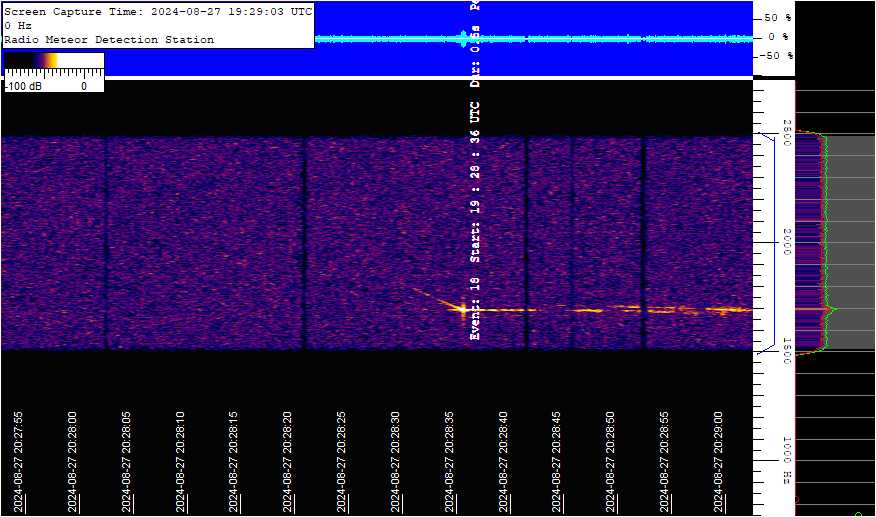Observation by Chris Holt: Radar scatter by reentering Starlink sat...
Uploaded by
Chris Holt
Observer
Chris Holt
Observed
2024 Aug 27 - 19:29
Uploaded
2024 Sep 04 - 15:03
Objects
Meteor
Equipment
- Nooelec NESDR Smart v5 software defined radio
- 3 element Yagi antenna
- HDSDR and Spectrum Lab software running on netbook computer
Location
Aston, Bampton, Oxfordshire
Target name
Reflection of Graves radar signal believed to be by reentering Starlink satellite 2382 (ID 47801)
Title
Radar scatter by reentering Starlink satellite
About this image
A bright fireball was seen across much of western Europe at about 19:29 UT on 27th August. The IMO's fireball webpage for the event includes numerous photographs and videos of the fireball. The IMO has identified the fireball as the reentry of a Starlink satellite. According to the Aerospace.org reentries site , the satellite is likely to have been Starlink-2382 (ID 47801), which was predicted to reenter at 19:48 UT ± 3 hours.
Over the summer, I have set up a software defined radio receiver to monitor meteor reflections of the 143.05 MHz radar signal from the Graves NEO (near Earth object) radar near Dijon. On 3rd September 2024, there was an appeal via the RMOB (Radio Meteor Observing Bulletin) Facebook Group for radar echoes that might be associated with this satellite reentry and I found that my system had recorded a likely echo at the appropriate time, as reported here.
The plot has time along the horizontal axis and increasing frequency of the audio-converted sideband of the radar signal on the vertical. The sloping line from about the centre of the plot is the typical response from a satellite moving through the radar beam. The multiple horizontal lines to its right are the 'overdense' reflections from a strongly ionised trail typically left by a larger meteor - presumably, in this case, associated with the breaking up of the satellite.
Files associated with this observation
Like this image
Comments
That's a very interesting plot. I picked up this event on one of my meteor cameras and the contrast-stretched video is here. The trail is first visible above the tree on the right at 19:28:18 UTC. It was still bright twilight but ionised trail behind the spacecraft is clearly visible along with a few flashes along the way. It would be interesting to see if they correlate with your recording.
Thank you for your interest, Nick. I have checked and the Samsung NC10 netbook is setting its clock automatically using time.windows.com. Its clock also agrees with my smartphone and radio controlled clock, so the times recorded in the plot from the system clock are likely to be accurate. I have looked at your video, which I imagine was from an SSE or SE facing camera both as the expected track was from NW-SE and my antenna is at 135 degrees (SE) and 10 degrees altitude (towards the sky high over Graves), and note a prominent brightening at 19:28:36 and in this linked screen grab . That time corresponds to the transition from the gradient to the horizontal overdense reflection in my plot. A speculation might be that is when the satellite changed from a hot but metallic body to a broader ionised trail.
The camera is in Chelmsford looking SE over northern France. The event at 19:28:36 does look more than a coincidence. Before that you were getting scatter from a rapidly decelerating object with a decent radar cross section. At that point it disintegrated into many smaller parts and you then get scatter from the stationary ion train. It would be interesting to work out the geometry of this. What sense is the frequency here? Prior to 19:28:36 is it consistent with the change in path length from the transmitter bouncing off an object which is decelerating and moving away from your receiver but towards the transmitter.
There are lots of multiple detections of this on the Fripon network so you can piece together the track. We also know the pre-entry orbit so would be able to work out the path fairly easily.
Copyright of all images and other observations submitted to the BAA remains with the owner of the work.
Reproduction of work by third parties is expressly forbidden without the consent of the copyright
holder. By submitting images to this online gallery, you grant the BAA permission to reproduce them in
any
of our publications.


